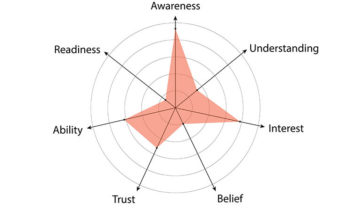Servant Leadership
Leadership is not just Braveheart-come-follow-me. It’s also a healthy dose of listening to those one wants to lead. What is the market saying? What are those closest to your customers hearing? What are your potential customers reporting?
PIE Director, Susie Krueger, describes the art of active listening with passion. Much of Susie’s workday is spent interviewing executives with whom her clients want to work. Susie says that when she talks with executives, their first instinct is to throw up an everything-is-okay smokescreen. It takes some digging to get to the truth. Simply asking, “What are your challenges?” is not sufficient. You have to ask five whys to uncover the heart of their challenge.
Q1: “What are your biggest challenges?”
A1: “I am working to drive interest in our website.”
Q2: “How are you thinking about doing that?”
A2: “The best way to get people to a website is to send out thought leadership with an offer that refers back to the website.”
Q3: “What are the barriers to you as you try to get that done?”
A3: “I have to create a thought leadership engine across the organization that serves all stakeholders.”
Q4: “As you think about that, where are the sticking points?”
A4: “I have to coordinate our managing directors who have research they want to publish with our brand people who want to present a consistent look and feel to our calls to action.”
Q5: “What makes this coordination difficult?”
A5: “Look, my job is to drive traffic to the website. That is something against which I am measured. The practice leads just want to get their stuff out to customers but don’t have an ROI, much less brand perspective. But they have much more power in the organization than me. I end up with the political problem of how do I reconcile their more powerful, but uninformed instincts, with a cohesive marketing strategy.”
Uncovering deep challenges, however, is only part of Susie’s job as she tries to be of service to the executive who has just bared their soul. There is a second step.

It is as though there is a part of servant leadership that might be termed called “servant sales,” and it sits right at this pivot from a deep understanding of those whom an expert wants to serve to the potential to collaborate. It’s not this:
Sounds like you have a mess over there. Let me send you a brochure of our offerings because we are the best people you could hire to straighten things out.
Rather, begin with a simple positioning statement:
I hear that a lot of that from marketing professionals.
This validation of the challenge the executive is facing is both comforting to the executive (No, I am not stupid or incompetent) and positions the service provider as a bee buzzing around companies cross-pollinating best practices. It positions the expert services provider not as the font of all knowledge (I am smarter than you), but rather as a smart peer who happens to have a different but complementary set of experiences which, when combined with the expertise the executive has about her company, could be the foundation upon which a collaboration might be built.
Susie says it best. Your job is to be an “ally in their quest to overcome their challenge.” In a phrase, be a servant leader.




